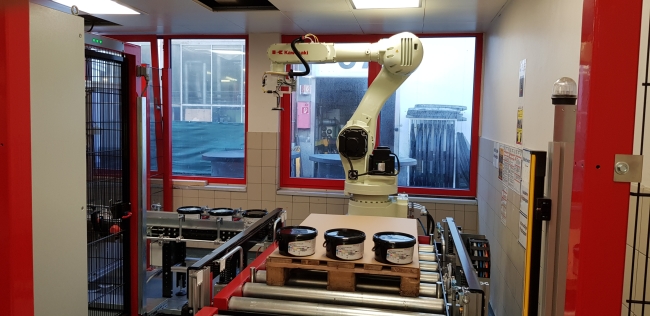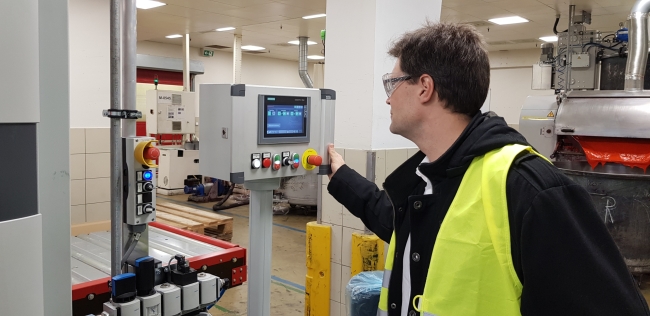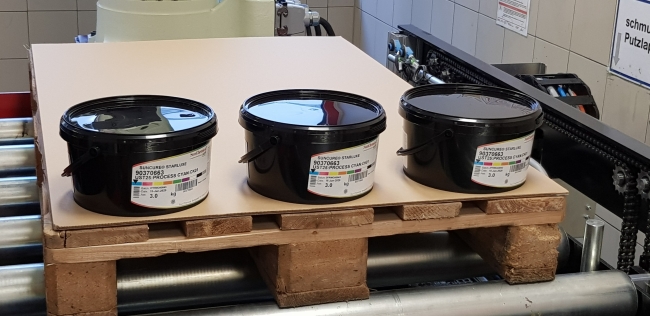5 minute read • published in partnership with Kawasaki Robotics
Case Study: Sun Chemical automates ink production to increase factory capacity
Sun Chemical, a member of the DIC group, is a leading producer of printing inks, coatings and supplies, pigments, polymers, liquid compounds, solid compounds, and application materials. Together with DIC, Sun Chemical has annual sales of more than $7.5 billion and over 20,000 employees supporting customers around the world. At its production site in Frankfurt am Main Sun Chemical manufactures printing inks for direct delivery of products to customers in Europe and the rest of the world. In the summer of 2019, Sun Chemical implemented a new robotic application in Frankfurt to support its continued growth.
Recently, the demands on the production capacities at Sun Chemical in Frankfurt am Main increased considerably, so that the need for appropriate automation quickly became clear and was also confirmed by the US group management. The goal of the new solution: to achieve a sustainable improvement in the efficiency and productivity of existing processes.

Picture: Kawasaki Robotics
The premises in an industrial area in the eastern part of Frankfurt posed several challenges for the planning: The limited space in the older building had already been used to a considerable extent, the floor was partly uneven, the ceiling was low and there was a wide window front directly behind the future robot cell. Nevertheless, the new robot system had to be integrated into the existing production and a smooth pallet transfer had to be possible.
Becker Sonder-Maschinenbau and Kawasaki Robotics were chosen
Initial contact with the system house and robot manufacturer was established at Fachpack 2018 in Nuremberg. While offers were also obtained from Denmark, Spain and Italy, the choice quickly fell on Becker Sonder-Maschinenbau and Kawasaki Robotics after the initial meeting at the trade fair. The presence in Germany was definitely a decisive factor: high quality and flexibility, reliability, as well as the local proximity of the Becker Group, were important.
In particular, maintenance and fast support are enormously important for smooth operation of the plant and long-term investment security. Becker Sonder-Maschinenbau has been working with Kawasaki Robotics products for a long time, and the customer was also quickly convinced of the quality and reliability of the robots.
Shortly after the FachPack, Sebastian de Man, Division Manager Robotics of Becker Sonder-Maschinenbau, visited Sun Chemical for the first time and got an idea of the requirements, production and infrastructure on site. After examining several options, the order was placed in April 2019 and the new system was already commissioned in October of the same year.

Picture: Kawasaki Robotics
It has not been the first experience with robots for Sun Chemical in Frankfurt: For several years now, a cartesian robot with three linear axes from a Danish manufacturer has been used elsewhere in the production facility. However, the 5-axis jointed-arm palletizing robot from Kawasaki Robotics clearly surpasses it in terms of precision, flexibility and working range.
Production at Sun Chemical Frankfurt is usually run in two shifts and can be run through the new robot cell without interruption. However, three shifts are also possible at any time if required and are used regularly depending on the required production volume. The robot-supported system allows maximum throughput without breaks. Manuel Krause, Engineering & Maintenance Manager Germany at Sun Chemical, explains: “With two shifts, automation by robots definitely pays off. For three shifts it is absolutely essential”.
8 to 10 buckets per minute and up to 12,000 kg of paint per day
The finished ink is filled into 3 kilogram buckets, sealed and automatically labelled. A Kawasaki RD080N robot is equipped with a specially designed vacuum gripper and transports the closed, labelled buckets to a waiting pallet. With a maximum payload of 80 kg and a reach of 2,100 mm, the RD080N is designed specifically for palletizing applications. With industry leading work range and reliability, the high-speed palletizing robot helps companies improve production line efficiency.
As soon as the pallet is completely loaded, it is removed by an employee via a roller conveyor for film wrapping as well as further loading and replaced by an empty pallet. The robot can resume operation immediately after the change. Particularly good for long-term planning: the system and the robot are currently running at only 50 to 80 percent of the available maximum capacity – there is still plenty of room to adapt to increasing requirements.
The system forms the end of the production process and can quickly become the bottleneck of production. But since it has been commissioned, the production capacity has been consistently higher.

Picture: Kawasaki Robotics
Relief for the employees
In addition to increasing production capacity and long-term cost savings, the focus was also on relieving the ergonomic strain on employees. The handling of the paint buckets, the pallets as well as the regular readjustment were challenging for the employees in the long run – especially for older colleagues or those with physical complaints.
Despite initial scepticism, the system and the robot were quickly accepted and appreciated by all employees, reports Manuel Krause: “The solution must be robust and reliable – then it will be accepted. And if it is not too complex and makes the daily work of our colleagues easier, even more so”.
The next robot cell is already in development
The next step in the automation of Sun Chemical’s Frankfurt production is already planned: A similarly designed robotic cell for palletizing the paint buckets – but with two parallel feeders. At present, a manual feeder is used at the point of production, but this will be automated together with a second one in the future.
The new double-deck palletizer – an innovation at Sun Chemical – will reduce downtime to a minimum. If the employee removing the finished pallet is on a break or otherwise not present, the system will stop until the pallet is removed. “This can take up to 30-40 minutes in individual cases – valuable time in production and filling. With the new system, the robot can continue packing even when the pallet is full and the system can continue to run around the clock,” says Krause.
A centrally positioned Kawasaki robot takes over the palletising. The new system will also have directly integrated labelling and will also handle larger containers and other coloured products.
